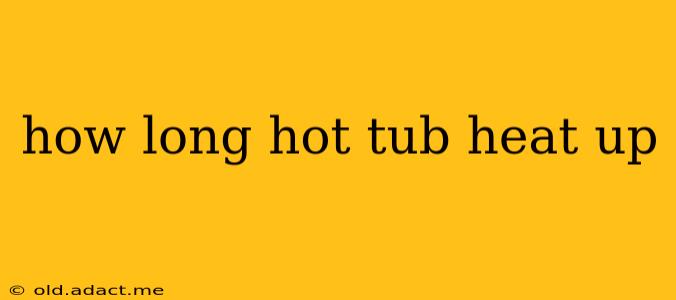Heating your hot tub for a relaxing soak shouldn't be a guessing game. The time it takes to heat your spa depends on several factors, and understanding these will help you plan your perfect soak. This guide will delve into the specifics, answering common questions and providing you with the knowledge to optimize your hot tub heating time.
What Factors Affect Hot Tub Heat-Up Time?
Several factors influence how long your hot tub takes to heat up. Let's break them down:
-
Hot Tub Size and Capacity: Larger hot tubs with a greater water volume naturally take longer to heat than smaller ones. Think of it like heating a teacup versus a bathtub – the larger the volume, the more energy (and time) is required.
-
Starting Water Temperature: The colder the initial water temperature, the longer the heating process will be. Heating water from a chilly 50°F (10°C) will take significantly longer than heating from a more temperate 65°F (18°C).
-
Ambient Air Temperature: Colder ambient air temperatures increase heat loss from the hot tub, prolonging the heating time. On a freezing winter's day, your hot tub will work harder to maintain its temperature, let alone reach the desired level.
-
Hot Tub Heater Power: The wattage of your hot tub heater is a crucial factor. Higher wattage heaters are more powerful and therefore heat the water faster. Check your hot tub's manual for its heater wattage rating.
-
Insulation: Hot tubs with good insulation minimize heat loss to the surrounding environment. Better insulation means faster heating and lower energy bills in the long run. Consider the type of insulation and its effectiveness in your specific model.
-
Cover Quality: A properly fitted and insulated cover significantly reduces heat loss. An older, damaged, or poorly fitting cover will allow more heat to escape, increasing the heating time.
-
Number of Jets in Use: Running the jets while the hot tub is heating will increase the heat loss and therefore increase the heating time. It's best to heat the water first and then switch on the jets.
How Long Does it Typically Take?
While there's no single answer, here's a general guideline: Expect a typical hot tub to take between 4 and 12 hours to heat from cold to a comfortable temperature (around 100-104°F or 38-40°C). However, with the factors mentioned above, it could be shorter or longer.
What if my hot tub is taking longer than expected?
If your hot tub is taking considerably longer than expected to heat up, investigate these possibilities:
-
Heater malfunction: A faulty heater is a common cause of prolonged heating times. Consult your hot tub's manual or a qualified service technician.
-
Low power supply: Ensure the power supply to your hot tub is adequate and functioning correctly. A low voltage can significantly impact heating performance.
-
Leaking water: A leak will constantly lower the water level, requiring your heater to work harder and longer to maintain the temperature. Regularly check for leaks.
-
Blocked filter: A clogged filter restricts water flow, hindering the heater's efficiency. Clean or replace your filter regularly, as per manufacturer instructions.
Troubleshooting: My Hot Tub Isn't Heating Up
This is a common concern, so here's a breakdown of troubleshooting steps:
-
Check the circuit breaker: Ensure the circuit breaker supplying power to your hot tub hasn't tripped.
-
Inspect the GFCI outlet: If your hot tub is plugged into a Ground Fault Circuit Interrupter (GFCI) outlet, check to see if it has tripped.
-
Examine the heater itself: Inspect the heater for any signs of damage or malfunction.
-
Check the thermostat: Make sure the thermostat is set to the desired temperature.
-
Test the water flow: Ensure there are no obstructions impeding water flow to the heater.
If you've checked all these points and the hot tub still isn't heating, contact a qualified hot tub service technician for professional assistance.
Maintaining Your Hot Tub for Optimal Heating
Regular maintenance extends your hot tub's lifespan and ensures efficient heating:
- Regularly clean and replace your filter: A clean filter ensures optimal water flow and heater efficiency.
- Keep the cover on: The cover minimizes heat loss and reduces heating time.
- Regularly inspect your equipment: Early detection of problems prevents more significant issues and ensures consistent performance.
By understanding these factors and implementing proper maintenance, you can optimize your hot tub's heating time and enjoy more frequent, relaxing soaks.
